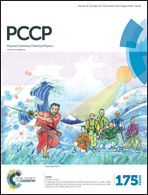Aggregates of quadrupolar dyes for two-photon absorption: the role of intermolecular interactions†
Abstract
We present a theoretical investigation of small aggregates of quadrupolar (A–π–D–π–A or D–π–A–π–D) charge-transfer dyes, with attention focused on the role of intermolecular interactions in determining their optical properties. We tackle the theoretical issue by adopting essential-state models (ESMs), which describe an isolated molecule in terms of a minimal number of electronic states, corresponding to the resonance structures. ESMs quite naturally describe intermolecular interactions relaxing the dipolar approximation and accounting for molecular polarizabilities. The approach is applied to curcuminoid and squaraine dyes, two families of chromophores with weak and strong quadrupolar character, respectively. The method is validated against experiment and for curcuminoids also against time-dependent density functional theory. ESMs rationalize the strong ultra-excitonic effects recurrently observed in the experimental optical spectra of aggregates of highly polarizable quadrupolar dyes, offering a valuable tool to exploit the supramolecular design of material properties.



 Please wait while we load your content...
Please wait while we load your content...